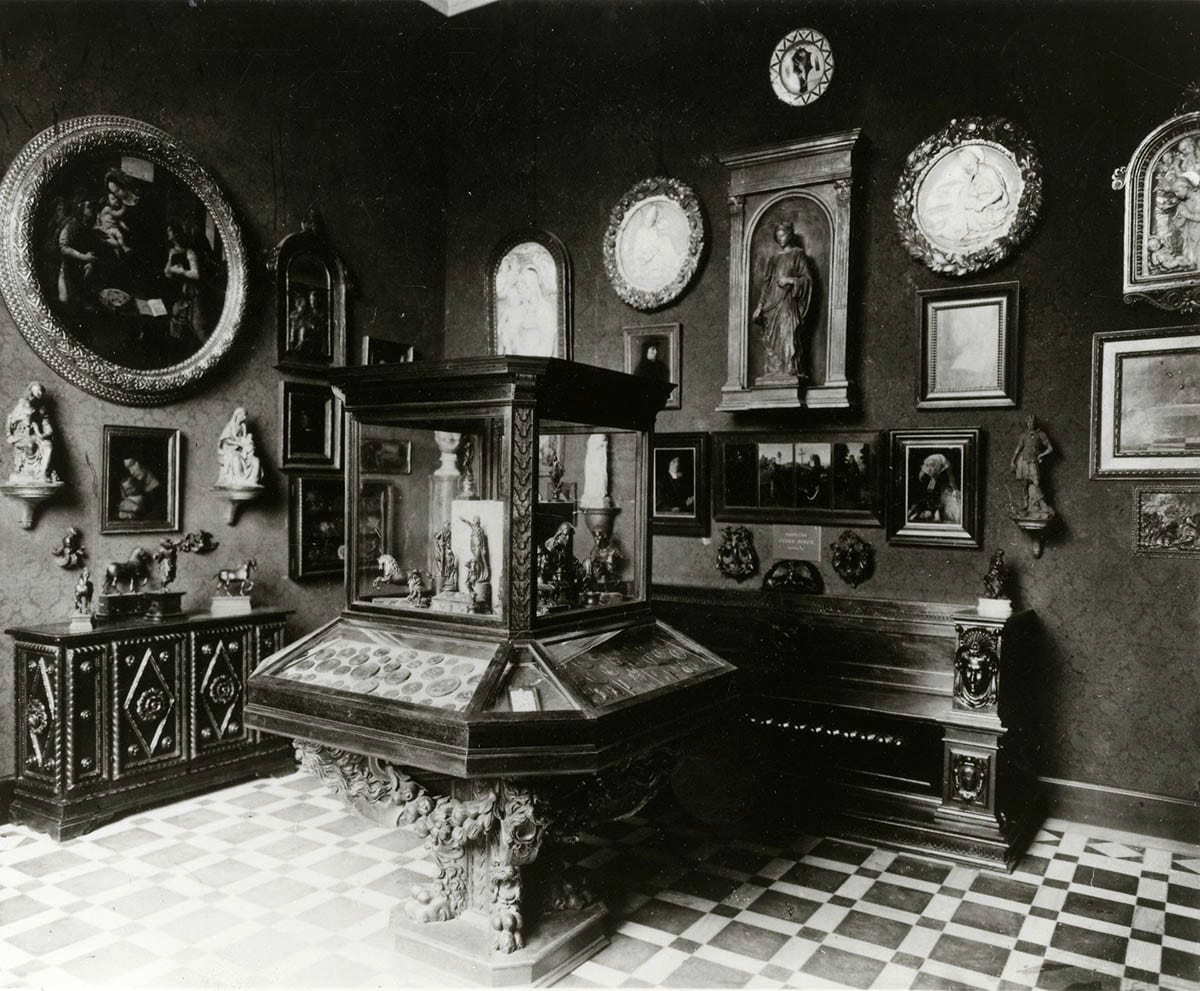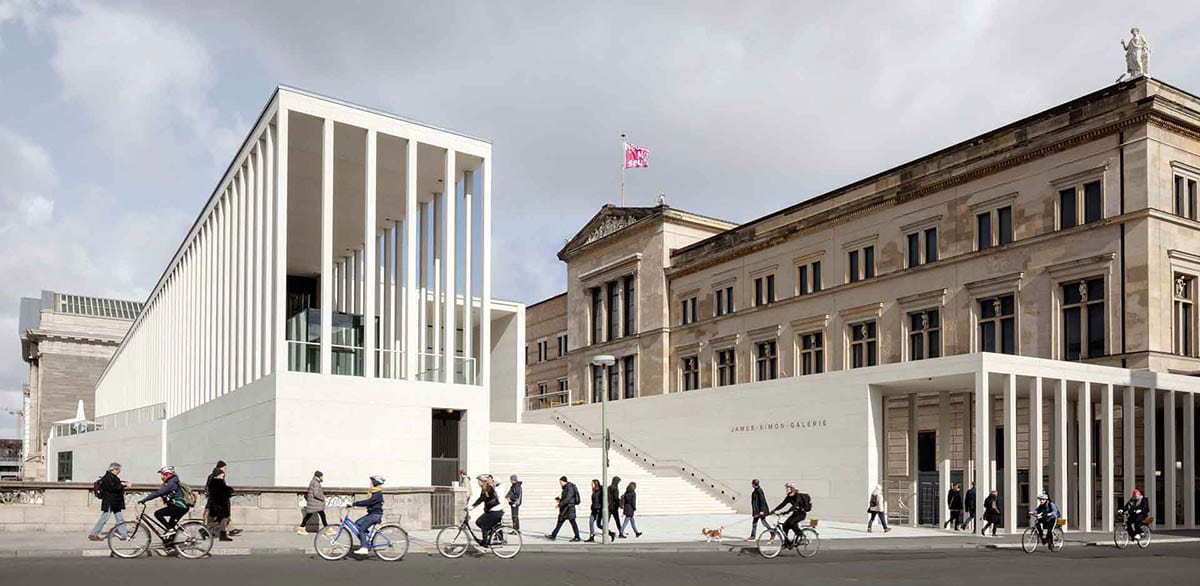
The architecture is light and airy. Visitors are welcomed by an expansive perron and elegant white colonnades. The James Simon Galerie not only bears the name of the famous Jewish art collector from the Wilhelmine period. With its modern shape and antique elements, the building exudes both the charm of the present as well as the past. The building by architect David Chipper-field is thus above all a symbol of the importance of James Simon – for the time around 1900 as well as for the present.
During his lifetime, James Simon created a huge private art collection and donated more than 10,000 art treasures to the Berlin museums. But it was not only the art scene James Simon rewarded with his generosity. The art collector is said to have donated a third of his total income to poor people. Who was this man who bears the titles entrepreneur, patron of arts and social benefactor as well as the nickname “Cotton King”?
James Simon: The “Cotton King”

Henri James Simon was born on September 17, 1851, in Berlin as a scion of a cotton wholesaler. At the age of 25, he had started to work for his father’s company which he soon made a global market leader. “Cotton King” first was the nickname of James Simon’s father, his own success as a cotton wholesaler let the nickname later be his, too. In his position as a cotton wholesaler, James Simon became one of the wealthiest industrialists in Germany. Together with his wife Agnes and his three children he lived a wealthy life in Berlin. The young entrepreneur used his newly gained wealth for his passion to collect art and make it accessible to people. Thus, by the turn of the century, one of the wealthiest people in Berlin became one of the greatest patrons of the arts.

In that time James Simon made acquaintance with Kaiser Wilhelm II. after the Emperor of Prussia asked different entrepreneurs for official economic advice. James Simon and Kaiser Wilhelm II. are said to have become friends in that time as they shared one passion: antiquity. There was also another important figure in James Simons’s life: Wilhelm von Bode, the director of the Berlin museums. In close cooperation with him, he led the “Deutsche Orient-Gesellschaft” (DOG) to excavate art treasures in Egypt and the Middle East. The DOG was founded in 1898 to foster public interest in oriental antiques. Simon donated a lot of money for different expeditions that were carried out by the DOG.
The Owner Of The Bust Of Nefertiti
Get the latest articles delivered to your inbox
Sign up to our Free Weekly Newsletter

One of these should bring world fame to James Simon, as it later did to the Berlin museums: Ludwig Borchardt’s excavations in Tell el-Armana near the Egyptian capital, Cairo. It was there that Pharaoh Akhenaton around 1340 BC had built Achet-Aton, the new capital for his revolutionary monotheistic solar state. This excavation campaign was extremely successful. The main pieces of the numerous finds were portrait heads of various members of the royal family of Akhenaton made of stucco and the unusually well-preserved painted limestone bust of Nefertiti, who was the pharaoh’s main wife. Since Simon was the sole financier and had concluded a contract with the Egyptian government as a private individual, the German share of the finds passed into his personal possession.
The Private Collector

While James Simon is still primarily associated with the find of the bust of Nefertiti, his possessions contained far more treasures. Years before the bust of Nefertiti was discovered in 1911, the Jewish entrepreneur’s house had transformed into a kind of private museum. In the Wilhelminian era, private art collections were regarded as an opportunity to gain and represent social significance. Like many other nouveau riches, James Simon made use of this possibility. When the Jewish entrepreneur acquired his first painting by Rembrandt van Rijn he was only 34 years old.
Art historian Wilhelm von Bode had always been an important advisor to the young art collector. Over many years a carefully selected and high-quality private collection with objects from different art genres was created by both men. In addition to antiquity, Simon was particularly enthusiastic about the Italian Renaissance. In a period of about 20 years, he had assembled a collection of paintings, sculptures, furniture and coins from the 15th to the 17th centuries. All these treasures were stored in the private house of James Simon. With an appointment, visitors had the possibility to come there and see his belongings.
The Benefactor Of Art

The idea of collecting art in order to make it accessible to other people has always been crucial for James Simon. This thought also underlies the donations he made to the Berlin museums, beginning in 1900. In the course of a new museum project, the 49-year-old donated his Renaissance collection to the state collections of Berlin. In 1904 the Kaiser-Friedrich-Museum, which is called the Bode Museum today, was opened. The museum was a central concern for Wilhelm von Bode for years and it was promoted by Kaiser Wilhelm II as a Prussian prestige project.
For Simon, as a collector and Prussian patriot, it was very important to be involved in this company. His Renaissance collection not only complimented the existing holdings, but it was also exhibited in a separate room called “The Simon Cabinet”. At Simon’s request, the collection was presented in a common variety – very similar to his private collection at his private home. It is precisely this motif of art presentation that was shown again in 2006, almost 100 years later, when the Bode museum was reopened after it had been renovated.
Berlin / Zentralarchiv

The bust of Nefertiti was donated to the Berlin museums by James Simon with a large part of his collection in 1920. It happened seven years after the bust and other finds from Tell el-Amarna found their place in his private collection. Then, numerous guests, above all Wilhelm II. admired the new attractions. On his 80th birthday, Simon was honored with a large inscription at the Amarna room in the Neues Museum.
His last public intervention was a letter to the Prussian Minister of Culture in which he campaigned for the return of the bust of Nefertiti to Egypt. That, however, never happened. The bust of Nefertiti is still “a Berlin woman”, as the author Dietmar Strauch called the treasure in his book about James Simon. In 1933, after the beginning of the anti-Semitic dictatorship of the National Socialists in Germany and before World War II, the aforementioned inscription was removed, as were all other references to his donations. Today a bronze bust and a plaque commemorate the patron.
The Social Benefactor

James Simon was a great benefactor of art. In total, he gave around 10.000 art treasures to the Berlin museums and therefore made them accessible for everyone. However, the Jewish entrepreneur was far more than only a benefactor in arts. James Simon was also a social benefactor, as he did not only support art and science but also spent a lot of his money – a third of his total income – for social projects. In an interview with Deutschlandfunkkultur, a German broadcast, author Dietmar Strauch explains that one can assume that this has something to do with Simons’s daughter: “He had a mentally handicapped daughter who only became 14 years old. He was busy all the time with sick kids and their problems. One can assume that his sensorium was sharpened for that.”
The reason why only a few people know about James Simon’s social commitment is that he never made a big deal out of it. As you can read on a Plaque in the Berlin district Zehlendorf, Simon once said: “Gratitude is a burden that no one should be burdened with.” There is evidence that he founded numerous aid and charity associations, opened public swimming pools for workers who otherwise could not have afforded a weekly bath. He also set up hospitals and holiday homes for children and helped Jewish people from Eastern Europe to start a new life in Germany and a lot more. Simon also directly supported a number of families in need.
Remembering James Simon

Entrepreneur, art collector, patron and social benefactor – if you consider all these roles that James Simon slipped into in his life, a broad picture of this famous man is painted. James Simon was a famous and socially recognized man within the framework of what was possible with the latent antisemitism of the time. Friends and colleagues described him as extremely correct, very reserved and always anxious to separate the personal from the professional. James Simon was presented with titles and honors, which he also accepted in order to not offend anyone. He did all that with quiet satisfaction but he eluded any public ceremony. James Simon died only one year after he had been honored in the Amarna room in the Neues Museum at the age of 81 in his hometown Berlin. His estate was auctioned in 1932 by the auction house Rudolph Lepke in Berlin.








